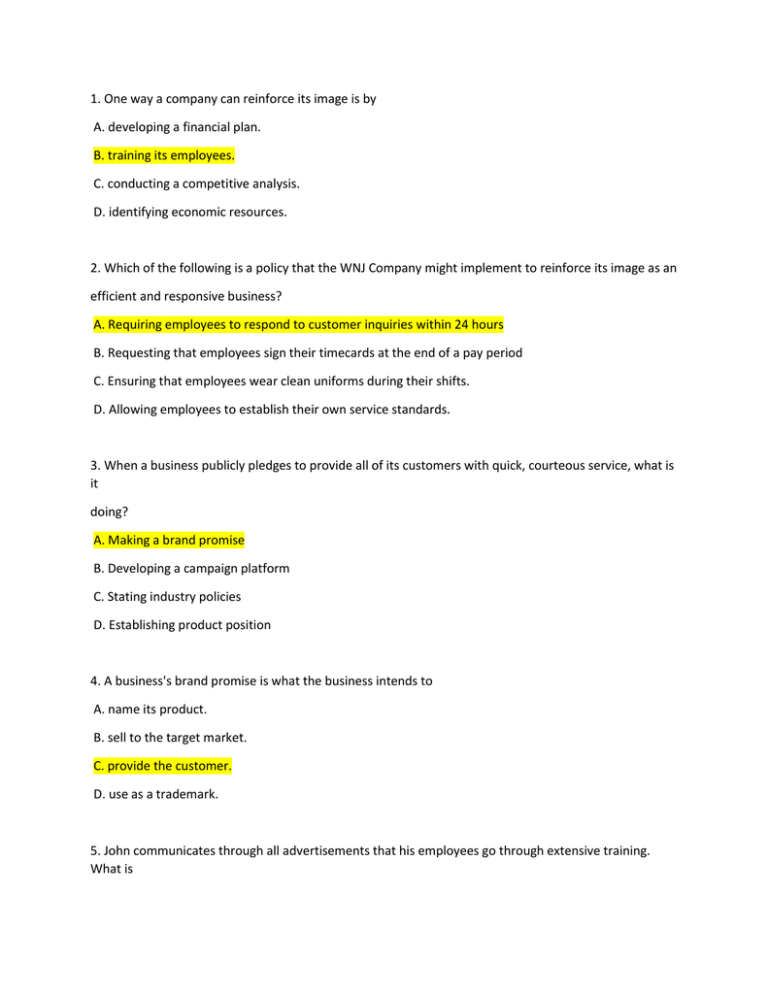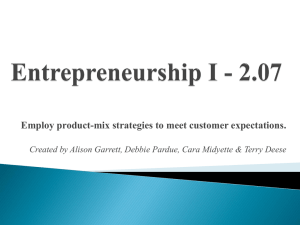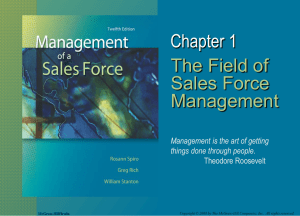File
advertisement

1. One way a company can reinforce its image is by A. developing a financial plan. B. training its employees. C. conducting a competitive analysis. D. identifying economic resources. 2. Which of the following is a policy that the WNJ Company might implement to reinforce its image as an efficient and responsive business? A. Requiring employees to respond to customer inquiries within 24 hours B. Requesting that employees sign their timecards at the end of a pay period C. Ensuring that employees wear clean uniforms during their shifts. D. Allowing employees to establish their own service standards. 3. When a business publicly pledges to provide all of its customers with quick, courteous service, what is it doing? A. Making a brand promise B. Developing a campaign platform C. Stating industry policies D. Establishing product position 4. A business's brand promise is what the business intends to A. name its product. B. sell to the target market. C. provide the customer. D. use as a trademark. 5. John communicates through all advertisements that his employees go through extensive training. What is John doing? A. Making a brand promise B. Developing a campaign platform C. Stating industry policies D. Establishing product position 6. One way of reinforcing the company's image through employee performance is by making sure employees have A. thorough knowledge of the products. B. comfortable work stations. C. generous pay and benefit plans. D. full access to customer databases. 7. What will probably happen to a business if it continuously fails to deliver on its brand promise? A. Lose credibility B. Improve sales volume C. Increase market share D. Decrease liability 8. What is an example of an employee reinforcing a firm's image through his/her job performance? A. A customer waits on the telephone for several minutes while Matt confirms shipping information. B. Susan advises her customer that the sofa is only available by special order. C. Jack politely asks if his customer would like a beverage while s/he waits for car service. D. Angela, a human resources manager, prepares the firm's employee newsletter every month. 9. Determine whether the following statement is true or false: All salespeople should use the step of the selling process in which a relationship is established with the customer. A. False, retail salespeople do not need this step. B. True, all salespeople make every contact permanent. C. False, industrial salespeople do not need this step. D. True, this is an important step for all salespeople. 10. What should a salesperson remember to do during the closing phase of the selling process? A. Show the customer a product B. Put the customer at ease C. Ask the customer questions D. Ask the customer to buy 11. By what will the emphasis put on each phase of the selling process vary most significantly? A. State and local laws B. Economic climate C. Product and client D. Geographic area 12. The phase of the selling process that includes writing up the order is A. discovering needs. B. prescribing solutions. C. reaching closure. D. establishing relationships. 13. After learning that a customer is interested in a computer that can produce sophisticated graphics, what should be the salesperson's next step? A. Trying to reach closure with the customer B. Suggesting a specific computer to the customer C. Trying to make the customer feel more relaxed D. Giving the customer a price list 14. Which of the following is part of establishing relationships with customers: A. Using suggestion selling B. Probing C. Reaching closure D. Sizing up the customer 15. On what does the speed of asking customers questions depend? A. Type of product that is being sold B. Number of other customers waiting C. Amount of time left before the business closes D. Pace of the customer's responses to your questions 16. Judy sold customers substitute computers for the iPad. What should she explain to the customers about the substitute computers? A. Buying motives B. Exchange policies C. Comparable features D. Fringe benefits 17. What should a salesperson explain to a customer when recommending a substitute item? A. Buying motives B. Exchange policies C. Comparable features D. Fringe benefits 18. If you feel you are asking too many questions but have not determined the customer's need or want, what can you do to vary your approach? A. Use questioning statements B. Wait for the customer to ask questions C. Ask questions more slowly D. Speed up the pace of your questions 19. A customer has been looking at different brands of the same product for several minutes. What is the most appropriate sales approach to use under these circumstances? A. "May I help you?" B. "Good morning. How are you?" C. "Brand X is on sale today." D. "What can I do for you today?" 20. What should the salesperson do when s/he is helping a customer and another customer enters the selling area? A. Apologize to the first customer for helping the second customer B. Leave the first customer to help the second customer C. Acknowledge the second customer as soon as possible. D. Ignore the second customer until finished with the first customer 21. Tim could not think of any more questions to determine a customer's need for a new stove. What should Tim do? A. Use questioning statements B. Wait for the customer to ask questions C. Ask questions more slowly D. Speed up the pace of your questions. 22. What is good advice for a salesperson to follow when questioning customers? A. Ask each customer the same questions B. Ask impersonal questions C. The more questions you ask, the better D. Make sure customers answer your questions 23. Analyze the following situation to determine how the sale was lost: Ms. Garcia asked a sales representative for a handheld scanner she'd seen at a trade show. The sales representative said, "You don't want that scanner. It's too slow and inaccurate. For a few more dollars, you can have this quality scanner instead." Ms. Garcia didn't buy. What had the sales representative done? A. Pointed out features of the scanner B. Suggested trading-down C. Criticized the original request D. Referred to the new item as a substitute








